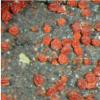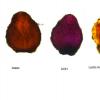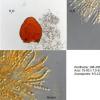
21-12-2025 09:32
Hello.A tiny ascomycete found embedded in wood in

21-12-2025 21:32
Pol DebaenstHello, Garden, Burgweg 19, Veurne, BelgiumOn 10/1

22-12-2025 23:38
Patrice TANCHAUDBonsoir, récolte sur un mur en pierre, apothéci

22-12-2025 00:47
Patrice TANCHAUDBonsoir, récolte à proximité du milieu dunaire

21-12-2025 21:40
Isabelle CharissouBonjour, j'aimerais connaitre les références de

20-12-2025 23:08
Patrice TANCHAUDBonsoir, récolte sur sol sablonneux dans l'arri�
 Hello to all,
Hello to all,I would like to hear your opinion about this "Pseudocosmospora" on Biscogniauxia capnodes.
The sole species of this genus occuring in Biscogniauxia is P. joca (Mycologia 105(5): 1296) and it is reported from Brazilian Amazon and also from Rio Negro Province (northern edge of Patagonia/Argentina) and I found it in the middle (São Paulo State/Brazil). The problem is that the micromorphology doesn't fit with the description provided, in Mycologia, by Herrera et al.
The perithecia are much smaller and the asci and ascospores are also smaller:
Herrera et al. My specimen (measurements in water)
Perithecia: 375-384 x 317-349 188-264 x 146-222
Asci: 90.7–112.6 x 8.8–11.1 75-90 x 7.5-8.5
Ascospores: 10.9–14 x 6.4–7.7 9.5-12 x 5.5- 7.0
Herrera et al. mention that "perithecia and ascospores of the epitype are larger than those reported in the literature", but I was unable to find an additional description of this fungus and I was wondering if someone could send me a copy of the protologue of Nectria joca (Nectria joca Samuels, Mycol. Pap. 164:21. 1991), and, of course, yours comments.
Thanks in advance,
Dartanha

here is the description of Nectria joca in Samuels 1991.
Regards,
Christian

Thank you very much for sending the original description of "Nectria joca".
The micromorphology of my specimen and that of the orignal description fits much better, except for the lenght of the asci.
Herreral et al. Orignal description My specimen
Perithecia: 375-384 x 317-349 210-270x180-240 188-264 x 146-222
Asci: 90.7–112.6 x 8.8–11.1 58-68x6.5-8.5 75-90 x 7.5-8.5
Ascospores: 10.9–14 x 6.4–7.7 (9.3)9.5-11(11.8)x5.6-7(7.4) 9.5-12 x 5.5- 7.0
Now I'm wondering why Herrera et al. chose the epitype with so "deviated" size.
Well, for now I will accept Pseudocosmospora joca, based on the original description, but I think that I need to isolate the fungus and check the anamorph to be sure.
Anyway, thank you very much for the help.
All the best,
Dartanha





 joca-0001.docx
joca-0001.docx